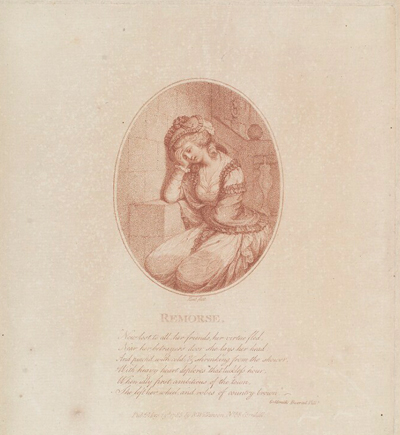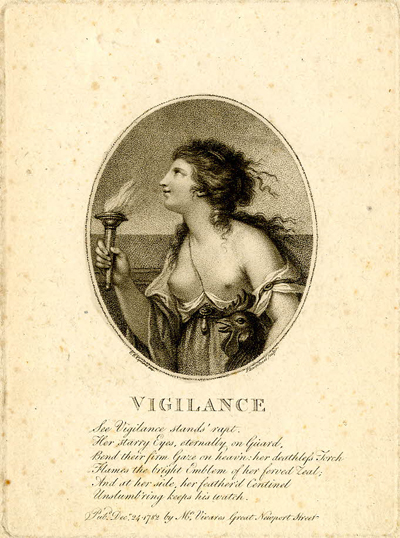Remorse
Working with the printseller, Robert Wilkinson, with whom he was to collaborate on approximately 30 prints over the course of his career, in 1783 Gillray created a pair of illustrations to Oliver Goldsmith's well known poem, The Deserted Village (1770), using the concept titles Innocence and Remorse. Both were part of Gillray's effort to establish a reputation for designing and engraving "serious" prints, an effort particularly strong in 1783 - 1785, but which continued sporadically into the 1790's.

© National Portrait Gallery, London
Written squarely in the pastoral tradition, The Deserted Village laments the disappearance of the purity and simplicity of rural life as progressive enclosures and growing commercialism were forcing or luring families out of their homes and into the cities. Innnocence illustrates and includes lines 327 - 330 from the poem where a young country girl "once, perhaps, in village plenty bless'd,/ Has wept at tales of innocence distress'd," but in Remorse she now finds herself in the same deplorable situation.
. . . lost to all, her friends, her virtue, fled,
Near her betrayer's door she lays her head,
And, pinch'd with cold, and shrinking from the shower,
With heavy heart deplores that luckless hour,
When idly first, ambitious of the town,
She left her wheel, and robes of country brown. (331 - 336)
The 18th century seems to have been rather fonder of abstract nouns than we are today. The poet William Collins, for instance, wrote a string of Odes to concepts such as "Pity," "Fear," "Simplicity," "Mercy," "Liberty," and so on. The 18th century engravers and print sellers seem to have followed suit. The prolific producer of stipple engravings, Francesco Bartolozzi engraved prints called Vigilance, Serenity, Contemplation, Prosperity, and Attention just in the two year period of 1782-83. These prints typically portrayed single figures, almost exclusively women (looking vaguely classical) in poses appropriate to the concept. Often, as in Remorse, they were enclosed in portrait ovals. And sometimes, as in the case of Vigilance, designed by Giovanni Cipriani, there was accompanying poetic text.

Vigilance [Dec 24, 1782]
© Trustees of the British Museum
Both Cipriani and Bartolozzi were members of the Royal Academy, so it is perhaps not surprising that Gillray, who received training at the Royal Academy schools would have tried his hand at a similar effort. But he may also have had in mind the example of Sir Joshua Reynolds, the contemporary President of the Royal Academy. Reynolds had created a single figure painting, The Old Man, based upon lines from The Deserted Village, which had been turned into a print by Thomas Watson with another concept title, Resignation (1772).

Resignation [March 1, 1772]
© Trustees of the British Museum
Gillray shows himself quite adept at replicating the softness (and sentimentality) of Bartolozzi's style of stipple engraving, but unlike Cipriani and Reynolds, he rejects the nudity and pillars of classical tradition and instead shows us a real English stoop and a modestly dressed English girl. From a modern point of view, the style and content are hopelessly mawkish. But this was still the age of sensibility, and as a freelance graphic artist, Gillray, first and foremost, had to understand the market.
The print is signed "Kent fecit," one of many aliases used by Gillray in the 1780s.
Sources and Reading
- Oliver Goldsmith, Full text of "The Deserted Village," Bartleby.com
- "The Deserted Village," Wikipedia
Comments & Corrections
NOTE: Comments and/or corrections are always appreciated. To make that easier, I have included a form below that you can use. I promise never to share any of the info provided without your express permission.